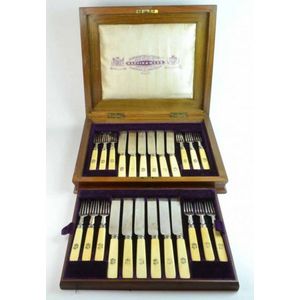Oak cased sterling silver cutlery set with bone handles
You must be a subscriber, and be logged in to view price and dealer details.
Subscribe Now to view actual auction price for this item
When you subscribe, you have the option of setting the currency in which to display prices to $Au, $US, $NZ or Stg.
- Canteen - A small cabinet, table or a box with drawers or lift out trays, for storing a set of cutlery.
- Old English Pattern - The Old English pattern as is commonly seen on silver flatware is characterized by a simple, clean shape with a slightly upturned tip and a broad handle that tapers gently towards the bowl or blade. The handle may be plain or decorated with a subtle design, such as a line or ridge along the edge or a small decorative motif at the tip. This pattern was first introduced in the 18th century and has remained popular ever since, making it a popular choice for traditional and formal table settings.
- Oak - Native to Europe and England, oak has been used for joinery, furniture and building since the beginning of the medieval civilisation. It is a pale yellow in colour when freshly cut and darkens with age to a mid brown colour.
Oak as a furniture timber was superceded by walnut in the 17th century, and in the 18th century by mahogany,
Semi-fossilised bog oak is black in colour, and is found in peat bogs where the trees have fallen and been preserved from decay by the bog. It is used for jewellery and small carved trinkets.
Pollard oak is taken from an oak that has been regularly pollarded, that is the upper branches have been removed at the top of the trunk, result that new branches would appear, and over time the top would become ball-like. . When harvested and sawn, the timber displays a continuous surface of knotty circles. The timber was scarce and expensive and was used in more expensive pieces of furniture in the Regency and Victorian periods. - Sterling Silver - Sterling silver is a mixture of 92.5% pure silver and 7.5% of another metal, usually copper. Fine silver is 99.9% pure silver, and is relatively soft and the addition of the very small amount of copper gives the metal enough strength and hardness to be worked into jewellery, decorative and household objects.
This item has been included into following indexes:
Visually similar items

A Victorian 24pcs, sterling silver fruit knives and forks set with Mappin & Webb retailers box 1878 Sheffield, with makers mark, comprising of 12 fruit knives and 12 fruit forks. Sterling blades and prongs with ivory handles, with walnut and mahogany case

An Edwardian silver and ivory six person fish service, engraved blades, ribbed collars, in original purple velvet and silk lined oak canteen

Silver plate cutlery service 'Grosvenor' in original box, approx 50 cm long, 29 cm wide

A silver plated cutlery set, for six, by Lambert London, including main and entree cutlery. Boxed
